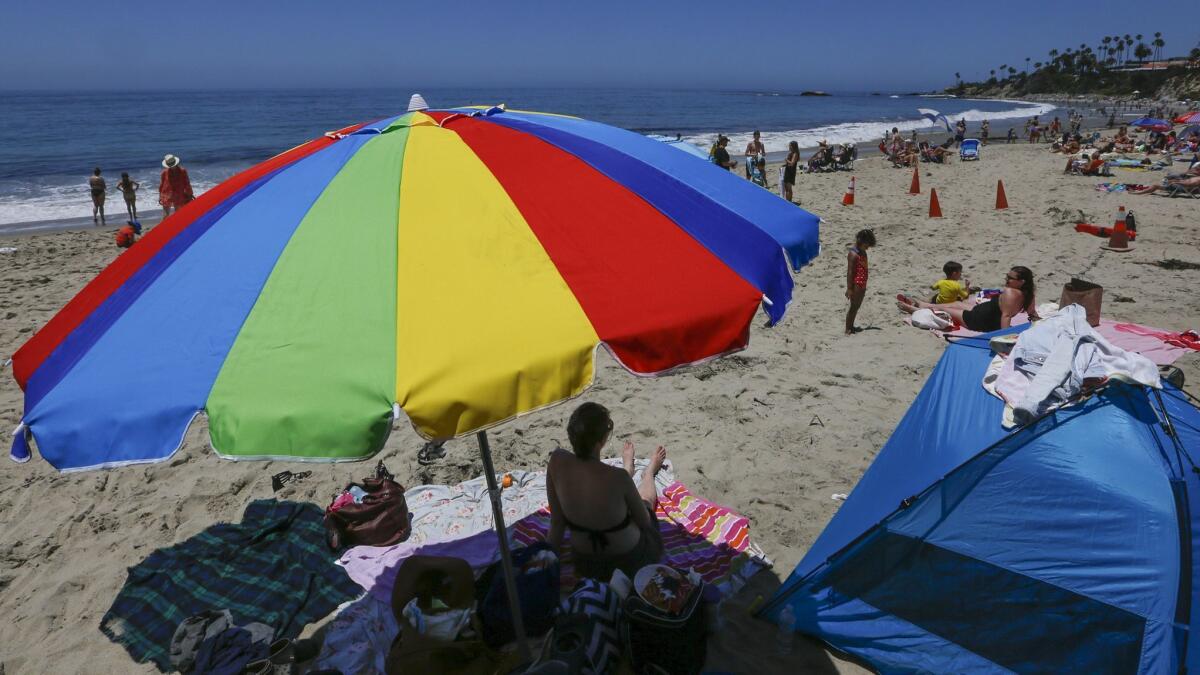Op-Ed: Climate change could wipe out L.A.’s June Gloom. Losing it would be disastrous

For many of us in Southern California, the marine layer is a lifesaver. Those low decks of clouds — you might know them as June Gloom or May Gray — roll in off cool, ocean waters, shading coastal regions and cooling beaches and West Side cities even as the Inland Empire scorches. Now, we may be losing them.
A new study by a Caltech climate scientist and two colleagues suggests those familiar low decks of stratus clouds could eventually become a casualty of the increasing CO2 emissions that are warming the planet. The loss of the clouds could, in turn, trigger a dangerous feedback loop: The fewer clouds there are to reflect solar radiation back to space, the warmer it would get on the Earth’s surface, leading to even fewer clouds, and to more warming.
We’ve seen the Earth warm nearly 2 degrees Fahrenheit since the Industrial Revolution, when humans started adding carbon dioxide to the air in copious amounts. The new model suggests a loss of stratus clouds could lead to a staggering 14-degree Fahrenheit jump in warming, a change that would indeed be catastrophic.
An analysis last year suggested Southern California’s marine layer has already thinned by 20% to 50% since the 1970s.
A few caveats are in order: First, as often happens with new research, scientists don’t all agree. Some say clouds aren’t likely to vanish as suddenly as the current study suggests. Others argue that cloud formation processes might be protected by global winds or other weather phenomenon.
And even if the Caltech scientists are right, human action can mitigate the effects. Already, it seems unlikely that we’ll see the tripling of carbon dioxide rates that would fully eradicate the clouds in this model, because we are turning to new and more efficient alternatives to fossil fuels.
Still, the study is well worth worrying about for two reasons. For one thing, it points out a major problem with climate models, which play a critical role in predicting how our planet will fare as it warms. No matter how sophisticated or powerful they are, or how many supercomputers are harnessed to run them, the models just can’t deal with clouds. While clouds greatly influence Earth’s climate, they are just too ephemeral, too subject to turbulence and literally too thin of a skin on the planet’s surface to be accurately categorized using current models.
The study’s lead author, Tapio Schneider, calls clouds “the blind spot” in climate modeling. He spent years trying to work clouds into a model because he was so frustrated by their absence in more traditional models. He’s working on a bigger and better model, dubbed the Climate Machine, that will take years more. It may be time we don’t have.
An analysis last year suggested Southern California’s marine layer has already thinned by 20% to 50% since the 1970s, likely due to both warming and urbanization. The thinning of clouds could be responsible in part for the ferocious fires we’ve seen in coastal areas in recent years. The prospect of a complete loss of clouds is terrifying.
Schneider said his model, even if imperfect, reveals there may be dangerous climate thresholds that current models don’t reflect. A similar loss of clouds, for instance, may help explain a strangely hot episode of Earth’s history 50 million years ago, when equatorial oceans were Jacuzzi-hot and crocodiles roamed the Arctic. Current climate models have had trouble explaining all that heat without assuming carbon dioxide levels were a nearly unimaginable 10 times what they are today.
Climate models are far from perfect. They are not crystal balls. But the risks that could accompany a warming climate — from rising sea levels that could engulf coastal cities, deadly heat waves and a loss or thinning of the clouds we rely on as natural air conditioners — are so great, we must pay attention to the imperfect computer models we do have and act as swiftly as possible to reduce greenhouse gases, and in doing so, reduce the risks to us all.
Usha Lee McFarling, a former science writer at the Los Angeles Times, won a Pulitzer Prize for explanatory journalism in 2007.
Enter the Fray: First takes on the news of the minute »
More to Read
A cure for the common opinion
Get thought-provoking perspectives with our weekly newsletter.
You may occasionally receive promotional content from the Los Angeles Times.






